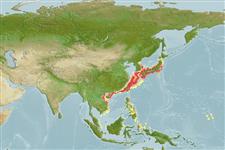Preferred temperature (Ref.
123201): 13.8 - 23.7, mean 21.1 °C (based on 46 cells).
Phylogenetic diversity index (Ref.
82804): PD
50 = 0.5001 [Uniqueness, from 0.5 = low to 2.0 = high].
Bayesian length-weight: a=0.00302 (0.00141 - 0.00645), b=3.24 (3.07 - 3.41), in cm total length, based on LWR estimates for this (Sub)family-body shape (Ref.
93245).
ระดับชั้นอาหาร (Ref.
69278): 4.0 ±0.62 se; based on food items.
Generation time: 7.2 ( na - na) years. Estimated as median ln(3)/K based on 2
growth studies.
ความสามารถในการกลับคืนสู่ปกติ (Ref.
120179): ต่ำ, เวลาต่ำสุดที่จะทำให้ประชากรเพิ่มขึ้นเป็น 2 เท่าใช้เวลา 4.5 - 14 ปี (Fec assumed to be <100).
Fishing Vulnerability (Ref.
59153): Moderate to high vulnerability (54 of 100).
Nutrients (Ref.
124155): Calcium = 17.6 [3.0, 82.8] mg/100g; Iron = 0.296 [0.079, 0.831] mg/100g; Protein = 17.2 [14.5, 19.8] %; Omega3 = 0.975 [0.309, 3.534] g/100g; Selenium = 7.51 [2.32, 23.13] μg/100g; VitaminA = 21.4 [6.5, 67.6] μg/100g; Zinc = 0.54 [0.26, 0.98] mg/100g (wet weight);
